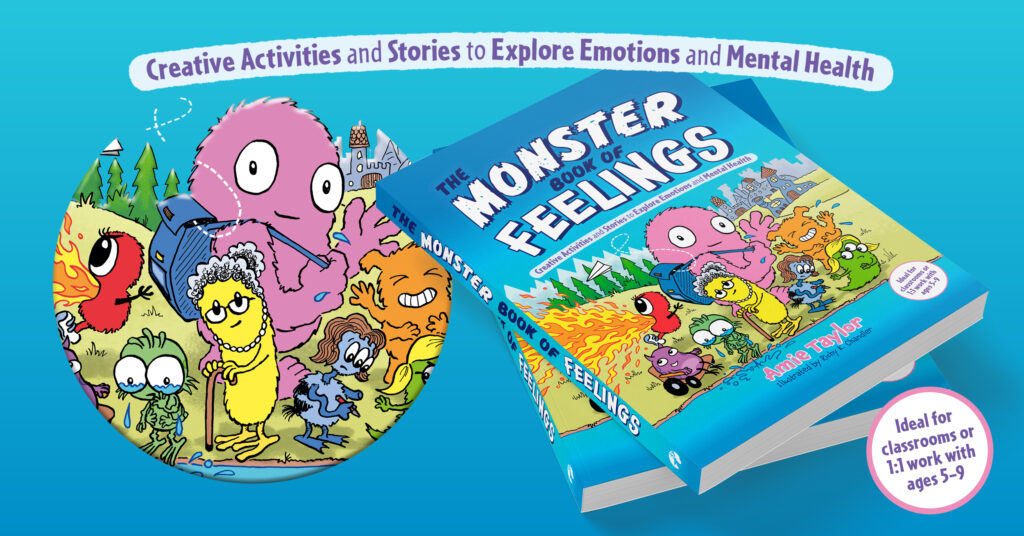
Working with children & emotions; an exercise for calming down a class
Amie Taylor, author of ‘The Monster Book of Feelings’, shares a tried-and-tested exercise for calming down a class so you can get the best out of them and help them to fulfil their potential.
Our feelings and emotions naturally shift throughout the day and can be influenced by a great number of things; if you work with children, have children or spend time with children, you are likely to be aware of the daily procession of sometimes quite intense feelings and emotions that occur.
“I believe that…understanding and accepting key feelings and emotions from a young age, is key in cultivating adults who are able to step up and take responsibility for their own mental health, and seek help when it’s needed.”
Amie Taylor
I am, by training, a drama practitioner, and many of the practical activities in The Monster Book of Feelings have been developed from years of working with both children and adults in theatres, nurseries, schools and universities. As a practitioner, I really believe in the power of building small practices, such as the one below, into daily school life to support mental health and wellbeing. Making even tiny changes to a daily routine can have a huge impact, which is why all activities in the book take under fifteen minutes to do with a child or group / class of children (many only 2-3 mins). The vast majority of activities are low-tech (nothing needed other than an imagination and yourselves), so that children can re-access these quickly when needed. Even these small practices can bring a deeper awareness for children around their mental health, feelings and emotions, supporting them to grow into more emotionally literate adults. Below is an activity for you to try, which works really well following transitional parts of the day (ie after break / lunch) and will support those children that may need a little longer to settle following a transition.
After-lunch visualisation:
I love this activity for calming a class down after lunchtime, to bring everyone back to the space, and it’s an opportunity for everyone to share an experience together before the afternoon lessons begin.
Ask your class to sit in their chairs, or on the carpet (wherever) and close their eyes. Explain to them that you are all going on a journey together. Ask them to take a few deep breaths before you begin. Use some calming music, or don’t – whatever works for you. You can choose what place you take them to – the desert, the mountains, the beach, an underwater cave or a treehouse in the jungle. For my example I’m going to take them to a lake in the forest, this is a much abridged version of what I would usually do in class, feel free to embellish, add bits and get lost in your own imagination while delivering this activity. Also, leave plenty of big pauses for the children to become immersed in the adventure.
“We are standing on the edge of the forest. There’s a cool breeze blowing along the pathway you’re standing on. The trees tower overhead and the golden sunlight streams through, warming your face. The forest floor is covered with twigs and bark and leaves, and is soft and crunchy underfoot. As you walk, you hear birds tweeting in the trees. You follow a river for a while, the water bubbling over the rocks. Eventually you reach a clearing in the wood, in front of you there’s a lake, the water is calm and still, the sunlight reflecting off the surface. You sit next to the lake and take a deep breath in…” and so on.
Depending on the mood of the group, I may ask them questions and take their responses. Questions such as what they can see or hear at certain points of the visualisation. What they can smell. How they feel being in the forest (this question can be a good lead into how it feels to be calm, how your body feels, what you notice etc).
After you have finished, bring them back slowly to the classroom, tell them to open their eyes and have a gentle stretch, letting go of the adventure you have just been on.
Extension:
If you wanted to extend this into a drama activity, you could work as a class to create a soundscape for the forest – each child choosing a different sound to make, for example: the wind blowing in the trees, birds, leaves rustling underfoot, the sound of the river, or any other animals they imagine to be in the forest. Using your hands signal to them how loud or quiet to make their sound (I tend to put my hands down low for quiet and up high for loud).
| Amie Taylor has 15 years’ experience making and delivering theatre and storytelling projects with and for children and young people. Her theatre company, The Shadow Makers, have created 4 shows for children aged 4-9, including Ice Island, about feelings, emotions and mental health, which inspired the book. She has also been a speaker for The Self Esteem Team, delivering talks on mental health in youth settings, and the drama lead for Our Time, a charity working with young people living with a parent or carer with a mental health issue. |
If you’d like to sign-up to the JKP mailing list, please click here.